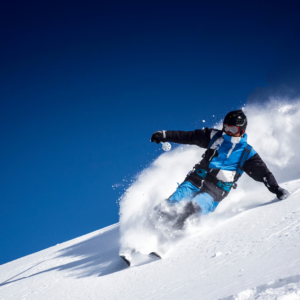No matter if you are hitting the slopes or stepping on the ice, follow these tips to prevent a sports-related injury during the cold-weather months
Winter activities and sports such as skiing, sledding, hockey and ice skating can increase a child’s risk for concussion. In fact, one 2009 study showed that there were more than 17,000 head injuries due to winter sports in the U.S. Nearly 7,000 of those injuries occurred in children under 14. Help your child avoid concussion due to winter activities and sports with the following tips.
Sledding
- Sled in an area with a clear path and avoid obstacles such as fences and trees.
- Sled feet-first instead of head-first, and have children sit up instead of lying flat.
- Keep younger children separate from older children to avoid potential crashes, the American Academy of Pediatrics (AAP) advises.
- If appropriate, consider having your child wear a helmet while sledding.
- Dress young children in several thin layers of clothing to keep them dry and warm during outdoor activities. Always remember to pack boots, a hat and gloves.
Skiing and Snowboarding
- If your child is new to a winter sport, sign them up for lessons taught by a qualified instructor before hitting the slopes. If it’s been a while since your child participated in one of these activities, have them take a brush-up lesson.
- Ensure your child has a helmet that is well maintained, age appropriate, worn correctly and certified for use.
- All children skiing or snowboarding should wear helmets and protective eye gear. Additionally, children who ski should have their safety bindings adjusted every year, and children who snowboard should wear gloves with built-in wrist guards, the AAP advises.
- The CDC offers specific guidelines for skiing helmets. To ensure a ski helmet fits your child properly, make sure it sits low enough in the front to protect the forehead—about an inch above the eyebrows. The back of the helmet should not touch the top of the neck. The CDC also recommends that children try on their helmet to assess fit with the goggles they plan to wear skiing before venturing out.
Hockey
- Children should wear helmets that fit properly, are age appropriate and certified for use. Helmets should be replaced after a serious fall or crash, as some helmets are only built to withstand one impact.
- Ensure your child’s additional ice hockey equipment, such as skates and protective gear, also fit appropriately.
- The CDC offers specific guidelines for hockey safety. In addition to a properly fitting helmet, hockey players should wear a cage or facemask, throat protector and chin strap. To make sure a helmet fits your child properly, the CDC advises making sure the helmet sits flat on the head and that the rim of the helmet is one finger width above the eyebrow.
Ice Skating
- Before setting foot on the ice, scope out the skating rink to be aware of any obstacles.
- Children should avoid wearing headphones while skating so that they can stay alert.
- Always skate in the same direction as the crowd, avoid quickly skating across the ice, and don’t chew gum or eat candy while skating, according to the AAP.
Snowmobiling
- No children under 6 should ride in snowmobiles or ATVs, and only children 16 or older should drive them, according to Brainline.
- Avoid pulling sledders or skiers using a snowmobile or ATV.
- Wear appropriate gear. This includes helmets, goggles, waterproof snowmobile suits, waterproof gloves and rubber-soled boots.
- Only drive when it’s light outside, and stay on marked trails.
Before setting out, it’s important to educate yourself on the common signs and symptoms of concussion. Early signs of concussion, according to the Mayo Clinic, can include headache or a feeling of pressure in the head, temporary loss of consciousness, dizziness, confusion, nausea, vomiting and fatigue. Changes in behavior, mood and personality can also occur. Seek medical attention if you think your child might be experiencing concussion.
By keeping these safety tips in mind, you can rest assured that your child will be as prepared as possible for winter sports.

